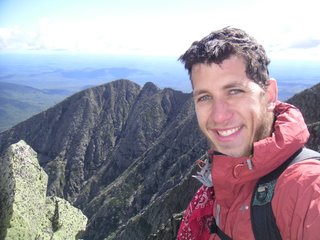Yesterday I took the day off work and went rock climbing with my assigned SMR mentor, Tony. I recently purchased most of the personal gear the team requires each member to have for ascending, belaying, and self-rescue, and I was eager to break it in as well as try out some of the techniques I've been reading about. While I was belaying Tony on our first pitch, he had a little slip, fell about 6 or 8 feet, and I arrested the fall with the help of our belay system: passive protection in the rock face, rope, and belay device. Thankfully, Tony was fine and we got to experience how the system works first hand.
There wasn’t much opportunity for photography because even when you're not climbing you're belaying or setting up/dismantling an anchor. I did manage to grab a few though.
 Tony setting up a top-rope anchor on the ledge above our second pitch.
Tony setting up a top-rope anchor on the ledge above our second pitch. Tony was the lead, I "seconded," and I had the these bags attached to the haul loop in the back of my harness so we could pull our gear up after us (ripped a hole in my pack, too =)
Tony was the lead, I "seconded," and I had the these bags attached to the haul loop in the back of my harness so we could pull our gear up after us (ripped a hole in my pack, too =)

 Here's Tony lead climbing a section that was supposedly rated 5.8 or 5.9. He came "off belay" at that little ledge so I could take the pic.
Here's Tony lead climbing a section that was supposedly rated 5.8 or 5.9. He came "off belay" at that little ledge so I could take the pic.
 This is a partially bolted route, meaning it's used fairly often and there are several bolts in the rock you can clip into for protection. Other protection we had to place as we went.
This is a partially bolted route, meaning it's used fairly often and there are several bolts in the rock you can clip into for protection. Other protection we had to place as we went.
 Hospital Rock is the name of the place inside Sequioa Natl' Park where we were. The face is over 300' feet high, although the section shown in this pic wasn't quite sheer.
Hospital Rock is the name of the place inside Sequioa Natl' Park where we were. The face is over 300' feet high, although the section shown in this pic wasn't quite sheer.
 A couple more bolts about 2/3rds of the way up. Beautiful spot to take lunch!
A couple more bolts about 2/3rds of the way up. Beautiful spot to take lunch!
 We had awesome weather. It was in the 70's .
We had awesome weather. It was in the 70's .
 Tony
TonySMR had an overnight winter training event a few weeks back. We reviewed snow anchors and various avalanche topics such as snowpack assessment, beacon work, and probing. Avalanches are no joke. Some of the world's most experienced mountaineers have met their deaths buried alive in snow that sets up like concrete once the slide stops. Anyway, training with the avalanche beacons is lots of fun. The beacons are simple transceivers that can transmit their position as well as home in on locations of other beacons. To practice, we simulated actual rescue/recovery scenarios by burying a beacon in the snow and then sending out teams or individuals to locate it as quickly as possible. It's essentially the same as your basic treasure hunt, but with a handheld device to tell you "hot" or "cold" instead of family members. But just like a sly older brother or uncle, the beacons can sometimes play tricks on you, giving a false signal due to interference, refraction, etc. At days end we dug some snug little tent platforms into the snow and set up camp. One of the cool things about winter camping in lots of snow is that you can level your tent site however you like, as well as dig trenches/benches for cooking. Again, not a whole lot of pics because we were pretty busy the whole time, but here are a few, out of order:
 staking down the tents using ice axes, treking poles, and snowshoes (regular tent stakes don't work in soft snow)
staking down the tents using ice axes, treking poles, and snowshoes (regular tent stakes don't work in soft snow)
 melting snow for water, using an avalanche shovel to keep the stove from melting through the snow.
melting snow for water, using an avalanche shovel to keep the stove from melting through the snow. Chuck's bivy, and the Big Baldy radio tower destroying the ambiance in the background.
Chuck's bivy, and the Big Baldy radio tower destroying the ambiance in the background.





